Back Pain, JOSPT, and Copyright Laws
Nov 03, 2021
Just in case you missed it, the latest physio brouhaha is now erupting on social media around some low back pain guidelines recently published that have come under a lot of criticism. This has also now devolved into arguments around tone, professionalism, but also academic copyright infringement.
This all starts with a tweet posted by the excellent Physio Meets Science Twitter account who consistently share and signposts therapists to many of the latest publications and research articles, if you don't follow them go and follow them now. They recently posted a tweet that contained a link to an open-access clinical guideline on low back pain in a journal called JOSPT here and included three screenshots of the title page and two of the tables from this 60-page document (see below)
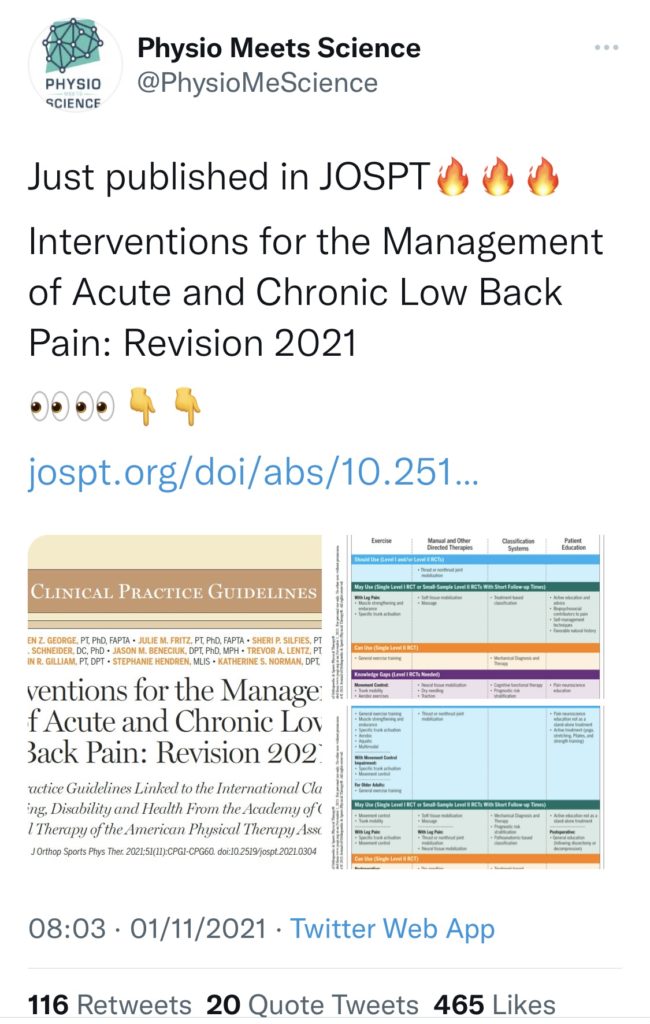
As you can see this tweet was ‘liked’ over 450 times and retweeted over 100 times, that's some great engagement for a research paper, you might be thinking that JOSPT would be buzzing at all that interest and information dissemination. The tweet was also quoted tweeted by a few, myself including giving some thoughts and opinions on this guideline, some positive, some not so.
Now my own opinions were not that positive because on my initial quick scan of this guideline, I thought this guideline was not very clear for the average physio (like me) who often skim reads these things and goes to the pretty pictures and tables to get a feel for the outcomes and results. I thought these had been very confusingly worded using a tiered system of SHOULD use, MAY use, and CAN use in their recommendations for specific treatments, and the tables had been poorly designed inferring a superiority of manual therapy treatment over and above other treatments, which when you dig down into the actual guidelines small print it actually doesn't support (see below).
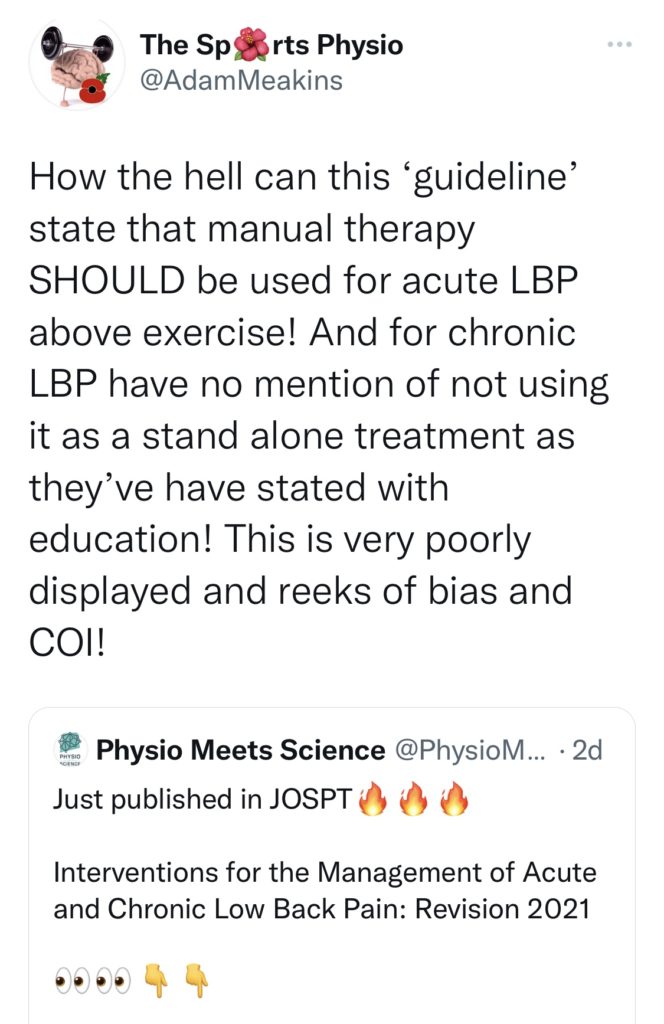
In my opinion, these clinical guidelines are often looked at by hard-working, time-strapped clinicians with at best mediocre statistical and methodology literacy, just like myself, to see if what they are doing is right and if there is any need to change or adjust their practice. Therefore I think it is imperative that researchers, authors, and publishers of these kinds of guidelines make their findings crystal clear and easy to read in a synopsis or table, and not bury the finer details or caveats in a small section of a massive 60-page document.
On further reading of the guideline, I also have other issues with it like the exclusion of some well-known back pain trials not being explained or justified clearly, not using the PRISMA or GRADE systems casting doubts about its methodological rigour, and separating 'soft tissue mobilisation' treatments which are claimed to be skilled techniques of moving specific tissues such as fascia and ligaments, from 'massage' which it states are general movements of the muscles alone. This ridiculous separation of basically the same treatments is both confusing and unnecessary, I mean just how the hell do you move muscles and not the fascia and vice versa
Anyway, I digress, so the comments and discussion around this guideline continued to develop and many others started to give more in-depth, specific, and skilled critical reviews of issues with this guideline. These threads again created more and more discussion and debate, but then suddenly these threads and the original tweet from Physio Meets Science disappeared and I was asked by some as to why.
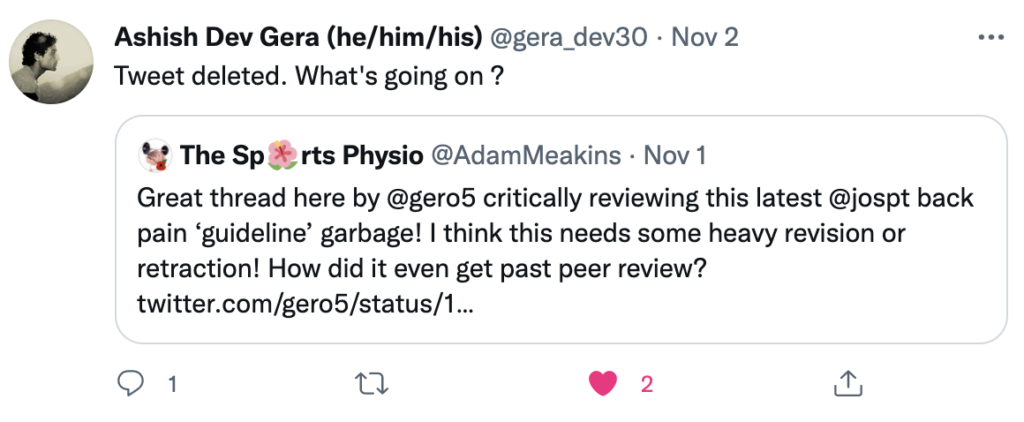
Now I had no idea, so I reached out to Physio Meets Science and asked them why their tweet was deleted. They replied and told me that JOSPT had contacted them and asked that they delete the tweet for copyright infringement.
Now, this didn’t sound right to me as their original tweet included the link to the free available, open-access guideline and they only shared 2 images from the 60-page document, hardly breaching copyright rules if you ask me. I also had some messages from colleagues about rumours that someone was upset at all the negative attention and criticism this guideline was getting and had asked JOSPT for these tweets to be deleted. Now again this didn’t sound right to me and so I thought I would ask JOSPT directly if these rumours were true (see below).
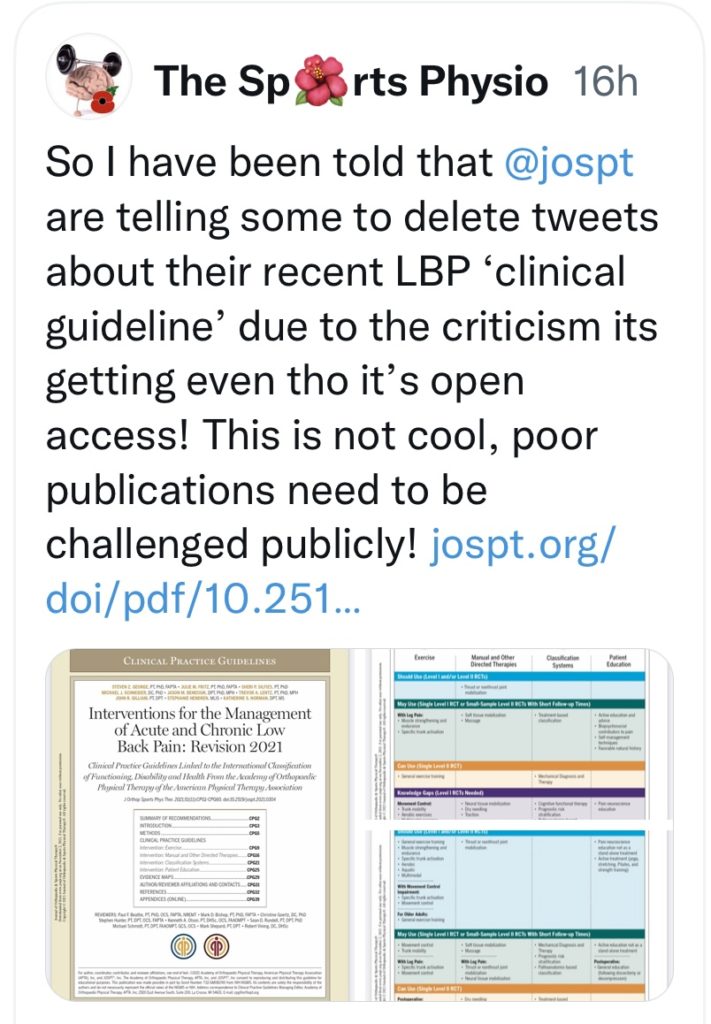
The reply I got from JOSPT was firm and definite no and that tweets were asked to be deleted only due to copyright infringes.
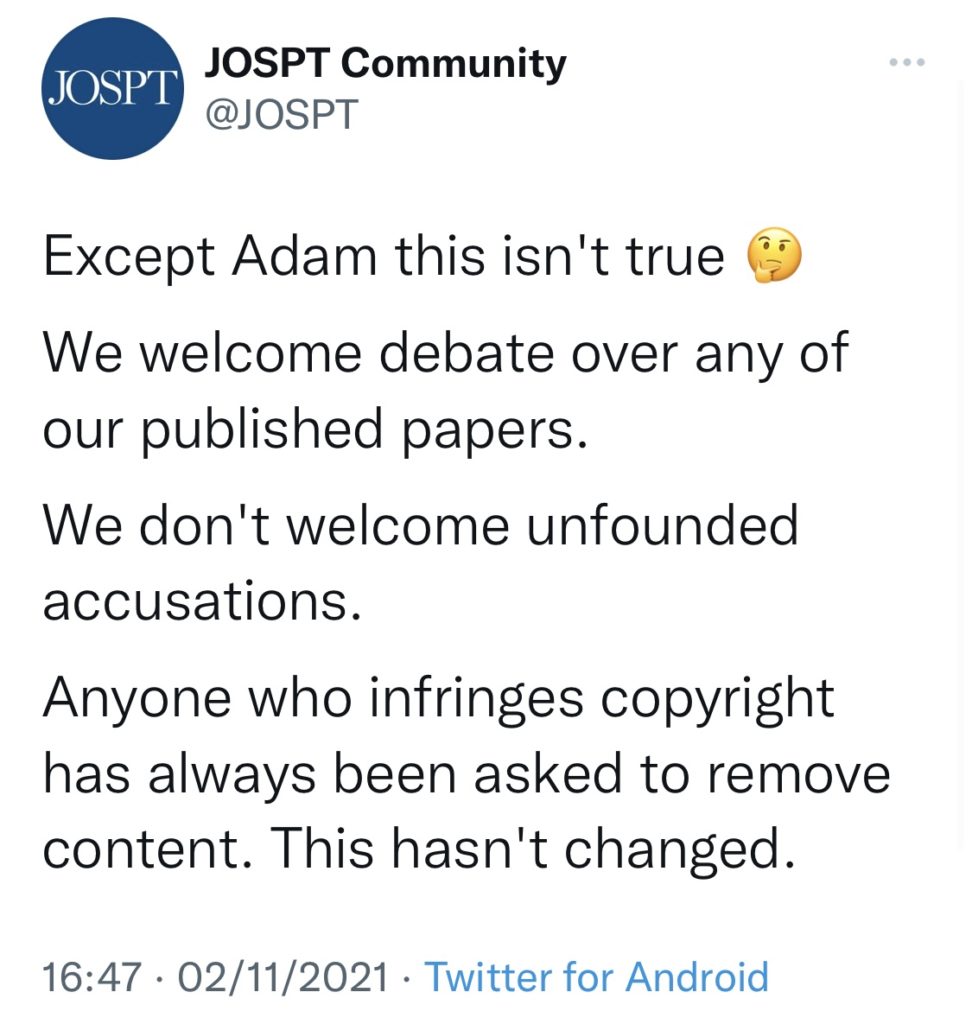
However, I was still confused by this response because as I understand under ‘fair use policy’ copyrighted material can be shared publicly for the purposes of education, comment, discussion, and critique as long as the original source is fully referenced and no money or profit is being made. So I asked them twice if they could expand a bit more on what copyright has been infringed and why. But I got no response.


I did however get a direct message a few hours later from JOSPT now asking for my tweet to be deleted due to it infringing copyright, and advising me that I may only post cropped or partial images but must refrain from posting full figures or complete pages (see below)... PS: I'm not a Dr.
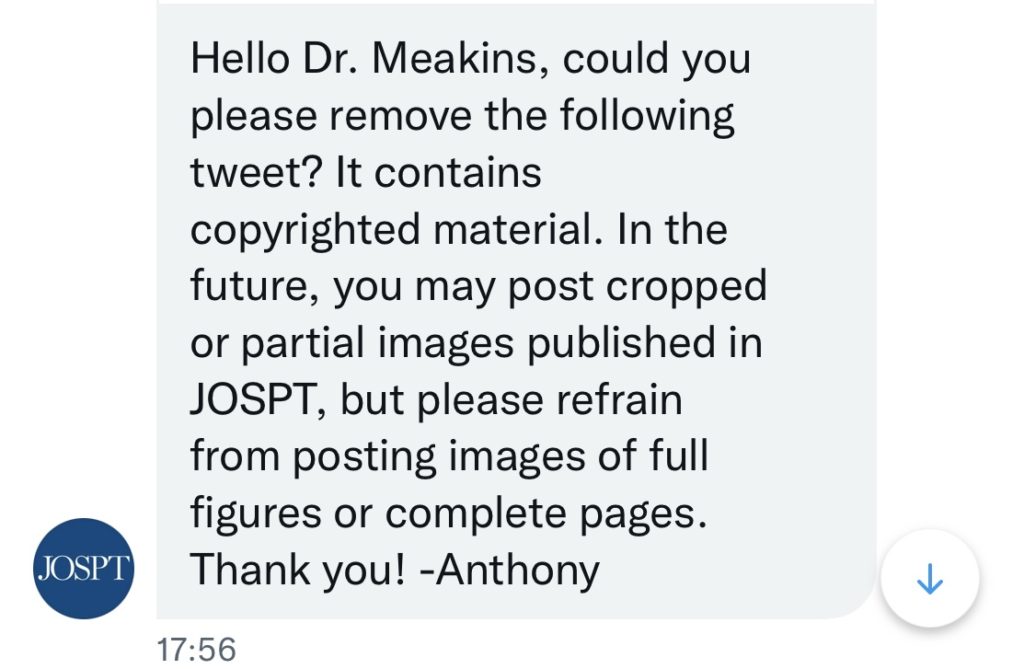
So I then decided to seek some legal advice of my own from a past patient and friend of mine who also just happens to be a very successful lawyer in the US to gain some clarification on copyright and fair use policy. After some checking, he came back to me and agreed that my tweet did not infringe copyright law. So I replied to JOSPT as such outlining my reasons and explaining that I will not be deleting my tweet.
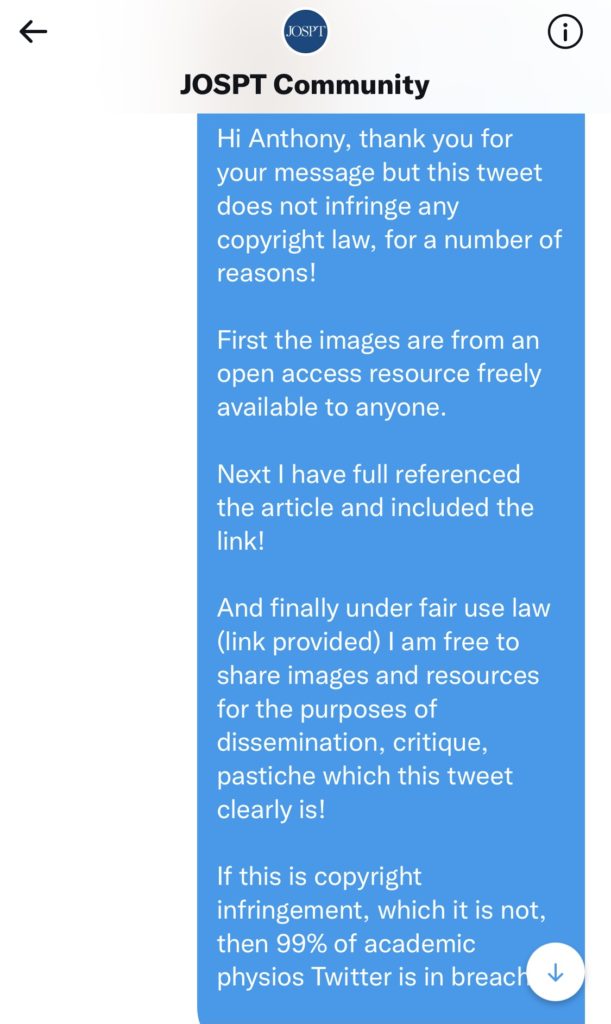
Within a few hours of sending that message, I then received what I can only describe as an overly aggressive, condescending and threatening email from a belligerent JOSPT copy editor threatening legal action unless I deleted the tweet within 24 hours.
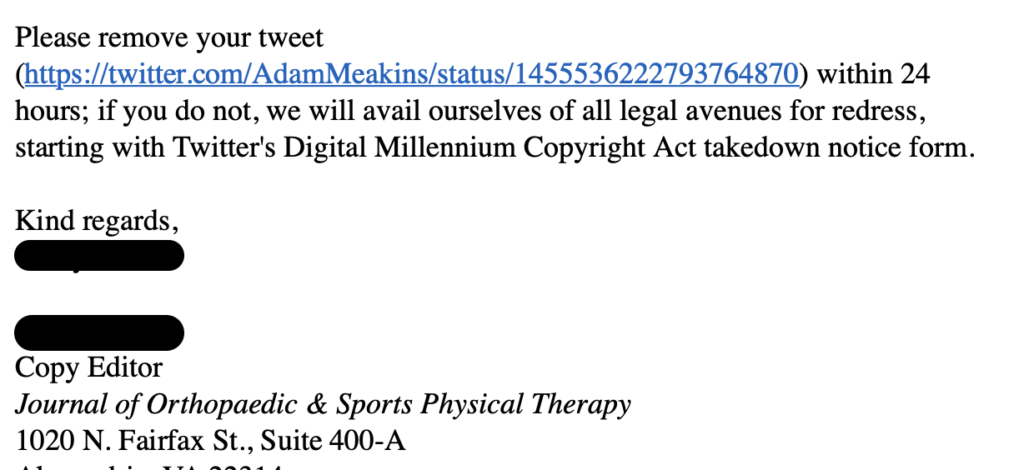
In this email, he stated that the fair use policy doesn’t apply to academic journals and is more for newspaper articles and book reviews, which is utter bullshit. He also went on to say that they are not asking others to delete their tweets or images as their comments were more professional and constructive in tone, whereas he thinks mine were not, which again is utter bullshit.
He also went on to state that the sharing of information on Twitter does NOT qualify as ‘educational’, which again is utter bullshit, and that the screenshotting of full pages or images is not allowed, however, screenshots of partial or cropped images are, which jut doesn't make any logical sense. I mean why is cropping images ok but not using a full one with full legal disclaimers and info included, and how much should they be cropped by, and what should be cropped?
So I replied that although I strongly disagree with everything he has stated I have neither the time, energy, or disposable income to get into a legal battle over copyright infringement, and so reluctantly and regetablly I caved and deleted my tweet under duress.
I did explain that I am not happy about being threatened and shall be sharing what has happened and why my tweet has been deleted on my social media with this blog, but so far I've had no further response from JOSPT.
So that's the current situation with another physio online fracas… or #CopyrightGate if you will. I'm sure there is more to come on this and I haven't heard the last.
However, I am deeply disappointed at being threatened and labelled as a malicious and destructive force by JOSPT or wanting to share my thoughts, critique and criticism of their poorly worded guideline. And so I want to encourage more discussion and debate on this topic of copyright and the sharing and dissemination of publications.
But for now, these interactions with JOSPT have done very little to reassure me that the rumours of attempted censorship and diversion away from negative comments and criticism are false. Unfortunately, my trust and faith in JOSPT as being a clear, transparent and reputable journal is gone, and I find it very hard to believe that JOSPT asked for my tweets to be deleted solely for copyright infringement reasons.
The current academic and scientific publishing industry has some major issues and it has come under some much-needed scrutiny and criticism lately. Not only do academic journals such as JOSPT have a monopoly on what gets published and how.
They also get researchers and reviewers to work for them for free, and charge extortionate fees to subscribers and institutions, making huge profits that are not used to advance scientific knowledge but more to line the pockets of their CEOs and shareholders.
It appears that some journals are now also attempting to control, police, and censor what is discussed, debated and critiqued on social media which is worrying.
For a good insight into how screwed up and corrupt the current academic publication system is check out this astounding Twitter thread here by Cory Doctorow.
Personally, I feel this whole debacle is being used strategically when it suits some journals or their associates to manage, limit, or censor comments, suppress criticism, and divert attention away from certain publications.
Because, when was the last time you heard of someone being threatened with legal action for sharing a publication or an image of an outcome graph or chart when it's getting positive feedback and rave reviews?
As always thanks for reading, and let's see if I get any further threats of legal action about this blog.
And JOSPT... screw you!
Adam
Stay connected with new blogs and updates!
Join my mailing list to receive the latest blogs and updates.
Don't worry, your information will not be shared.
I hate SPAM, so I promise I will never sell your information to any third party trying to sell you laser guided acupuncture needles or some other BS.

